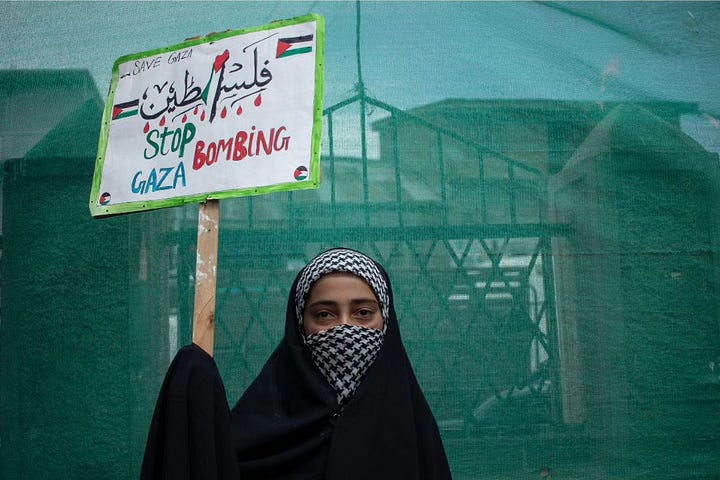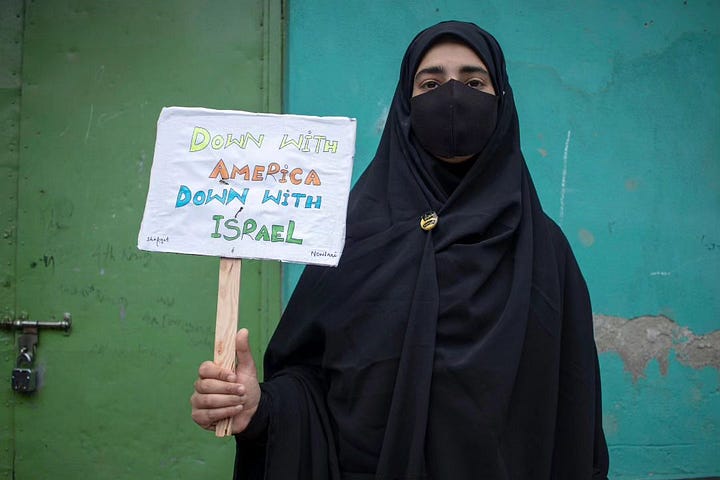From Kashmir to Palestine, ‘Azadi’ Belongs to the Struggle
Selective solidarity and exceptionalism in the student movement for Palestine
On the evening of April 18th, 2024, Columbia students re-occupied their campus lawn. Columbia President Minouche Shafik had authorized the NYPD to clear the area just ten hours earlier. More than 100 students, including three legal observers, had been forcibly arrested. Upon their return to the lawn, students chanted and sang late into the night in solidarity with their comrades. A video filmed that evening captured an Indian student leading the Azadi chant.
“Hum kya chahte?”
“Azadi!”
The video went viral on X. It was posted by @CampusJewHate – an account that falsely reports instances of anti-zionism as antisemitism at Columbia University – and was thus characterized by some as dangerous and antisemitic. Alongside the hate from Zionist accounts, the video was ill-received by Hindu nationalists, who saw this chant as leftist wokeness.
“What do we want?”
“Freedom!”
The video also faced criticism from Kashmiris, who called this out as yet another instance of leftist Indians co-opting the Azadi chant for their own causes, without acknowledging or standing in solidarity with the Kashmiri liberation struggle.
The criticism from Kashmiris demands serious consideration, as it underscores the need to recognize the chant’s deep-rooted significance in Kashmir’s struggle for liberation.

The word azadi has its roots in Persian, and translates to ‘freedom’ in Urdu. Though it would be reductive to pinpoint in one definition what the term means to each of Kashmir’s people, its primary connotations are of liberation from Indian occupation. For some, this liberation might involve becoming a part of Pakistan; for others, it coexists with a desire for an independent sovereign state. Usage of the term as a political slogan can be traced back to the 1947 poem ‘Azaadi’ by Ghulam Ahmad Mahjoor, a pioneer of Kashmiri poetry and language. His poem (excerpt below) encouraged a Kashmiri national identity that went hand in hand with the fight for freedom.
Bolaan osukh pinjras andar
Khootchi khootchi osukh karaan guftaar
Haal e dil saaf wann wouni kaehendi chhi tchey darr
Poshan kraav
Speak out bold and clear. Your voice
Need not falter with fear
As when you sang within your cage.
The slogan was later popularized by the Jammu and Kashmir Liberation Front (JKLF), founded in 1976 and viewed as the first group to have started an armed insurgency in Kashmir in 1989. According to former JKLF leader Javed Mir, it was in Srinagar, at one of the “first shows of weapons by militants” in early 1990, where the call-and-response slogan ‘Hum kya chahte? Azadi!’ (What do we want? Freedom!) was heard. Mir noted that the slogan articulated “what JKLF stands for: freedom from India and the secularity of the liberated Kashmir.”

Although azadi “doesn’t have a concrete shape or form [...] it means something”; it represents “a longing for dignity” and “something that [Kashmiris] desperately need”, Gulshan, a Kashmiri student at Ashoka University in India, told The Student Intifada. Azadi is deeply rooted in the Kashmiri experience specifically, because “one cannot exist free from fear in Kashmir”, she added.
Over time, the slogan has been embraced, and its meaning adapted, by protesters throughout South Asia for causes of their own - from women’s movements in Pakistan, to protests over 2024 rape at RG Kar at Medical College and Hospital. In 2016, JNU garnered significant attention for the use of ‘anti-Indian’ slogans – including the word azadi – at protests against the capital punishment administered towards Kashmiri separatists Maqbool Bhat, killed in 1984, and Afzal Guru, killed in 2013. The media’s focus on these slogans, the subsequent arrest of JNU’s Student Union President Kanhaiya Kumar, and the ensuing protests all played a significant role in bringing the slogan from Kashmir to the attention of India as a whole. This effect was amplified even further in 2019, when the slogan was chanted at protests nationwide against the discriminatory Citizenship Amendment Act (CAA), at universities including JNU, Jamia Millia Islamia, and Aligarh Muslim University.
In cases such as the above, the term azadi has become equated with ideas broader than the Kashmiri context it was born out of – ideas including freedom to protest, freedom from authoritarianism, and a secular India. The slogan has been labeled by some parts of Indian media and government as ‘anti-national’, and perceived as inciting violence when it is heard at protests even outside Kashmir. When those chanting azadi are questioned by authorities, they may adapt the meaning for their purposes to avoid being linked with the secessionist movement. Through this process, any solidarity for Kashmir that may have existed is erased, and azadi has been appropriated.
“It was particularly upsetting to see a video being circulated where Indian students were chanting Azadi without introducing it as a Kashmiri liberation slogan”, Maryam Iqbal, a Kashmiri student organizer with Columbia SJP, told TSI. She saw this as “an extension of the appropriation of the Kashmiri liberation struggle by the Indian left” – and given the small population of Kashmiri students at Columbia, this appropriation was never addressed or directly called out.
Discussing student movements, Gulshan noted that youth movements for either Palestine or Kashmir should not be seen as isolated, but rather as a part of a global network of solidarity. “The rise of activism and social media gives a voice [to students who] amplify the marginalized voices, share grassroots perspectives, and mobilize support.” Though Gulshan noted that the success of these movements “depends on other factors that surround them”, she still sees their potential, asking “if not us, then who?”

Many Indian liberals show their solidarity with Palestine while completely ignoring the occupation of Kashmir “because it is not as convenient for them”, Iqbal observed.
Gulshan explained, “every time this is used – by dominant Indians especially – they are romanticizing something brutal. It becomes an aesthetic tool, that is it. The slogan doesn’t define their aspirations, like us. They define the slogan instead.” For her, azadi when used by Indians becomes an abstract concept that defines the frustration meant to be fixed within the system. In Kashmir, it is an existential problem. To support the liberation of Palestine but not that of Kashmir is thus ignorant at best and disingenuous at worst, especially while simultaneously aestheticizing and decontextualizing Kashmiri chants for liberation.
Within Columbia circles, awareness of the occupation of Kashmir was lacking, Iqbal believed. Columbia SJP had organized a teach-in about the parallels between Kashmir and Palestine several weeks before the encampments went up. This prompted backlash from the Indian Students Association at Columbia, who put out a public statement condemning this teach-in and claiming that it was part of a “glaring and misleading trend.” They further added: “The comparison of such conflicts with the Union Territory of Jammu and Kashmir is inaccurate and out of context. The Union Territory of Jammu and Kashmir has always been an integral part of the Union of India and any attempts to equate it with any conflict around the world is misguided, unhelpful and it would neither be advisable nor desirable to equate and draw such parallels.”

Apart from the extremely callous relegation of global solidarity movements as a “trend”, there are several false claims made in this statement – the first of which being that comparison of Kashmiri and Palestinian liberation is inaccurate or out of context. The parallels between the two struggles are crucial. Ethnic cleansing is a foundational event in both cases: the Nakba for Palestine, and the Jammu Massacre for Kashmir. Furthermore, both India and israel “rely on similar forms of violence and dispossession, largely triggered by Islamophobia and the need to discipline and control the Muslim ‘other’”, as Middle East Eye explained.
As well as the killings, torture, and further atrocities that characterize everyday lived experiences in the occupied regions, both occupying powers implement similar hostile policies including “home demolitions, cultural aggression, erasure of history, refusal to hand over bodies for last rites, criminalization of protest, and strengthening of surveillance architecture”.
What’s more, the India-israel military-industrial alliance routinely shares arms and military technology that are battle-tested on Palestinians and used on Kashmiris. Alarmingly, ethnonationalist political scientists have even recently called for an “israel-like” solution in Kashmir.

Beyond their shared experiences of occupation, Palestinians and Kashmiris have long acted in solidarity with each other. ‘Save Gaza’ and ‘Support Palestine’ graffiti can still be seen splashed across walls in several parts of Kashmir. Pro-freedom parties of Kashmir organize demonstrations on Quds Day, on the last Friday during Ramadan, in support of Palestinian liberation. The Palestinian BDS movement has called for solidarity with Kashmiris living “under military repression that in so many cases is similar to israeli forms of subjugation and control”.
For Gulshan, who grew up in Kashmir, this link is deeply personal. Both peoples “try to reclaim their freedom and lives”, but see their voices drowned out in “broader geopolitical narratives”.
Furthermore, Kashmir categorically has not “always been” an integral part of the Union of India. At the time of the partition of India and Pakistan in 1947, the ruler of the princely state of Jammu and Kashmir had the option of acceding to either of the two dominions. Meanwhile, an uprising by Jammu Muslims against the Dogra ruler led the Dogra state army and Hindu supremacist militias to carry out ethnic cleansing of Muslims in Jammu. In an effort to suppress the rebellion, the Dogra ruler requested support from the newly formed Government of India, who agreed, on the condition that Kashmir accede to the Union of India. Because the Indian Army was present even before the treaty of accession was signed, and because the Dogra ruler did not have the right to make agreements on behalf of the people, this is seen by Kashmiri people not as an agreement but as an invasion.

A democratic vote for self-determination was promised to the Kashmiris in 1948 in the presence of the UN, a promise that has never been fulfilled. In August 2019, through a parliamentary decision, the Government of India stripped Kashmir of its special status, shifting its political landscape from that of an occupied territory to that of a settler colony.
Ultimately, Kashmir was occupied by the Government of India through force and deceit. It is “neither advisable nor desirable” for the Indian Students’ Association in Columbia to peddle the false narrative that Kashmir has “always been” an integral part of India. This is not true by any stretch of the imagination.


The teach-in made the Hindu Nationalists at Columbia so anxious precisely because parallels between occupied people created solidarity, according to Iqbal. Awareness of the Zionist occupation’s crimes is what has evoked significant mobilization in support of Palestine. To discuss Kashmir in any parallel context, then, would pose a direct threat to the insistent colonial narrative that Kashmir is a part of India. Gulshan drew attention to the fact that the fight to reclaim land and identity is perceived as a threat by occupying forces that utilize those to construct their own nationalism. This is the case in Kashmir and Palestine.
The greatest threat to the settler-colonial apparatus is the oppressed rising in unified resistance against their shared oppressors. But if we are to truly show our solidarity with interconnected liberation struggles, we must put in the work to understand and acknowledge their different contexts. It is only then that the chants of Azadi – from Kashmir to Palestine – will terrify those in the halls of the Empire.
Written by comrades from Kashmir, Pakistan, and India.


